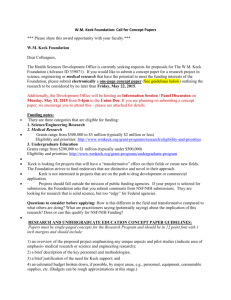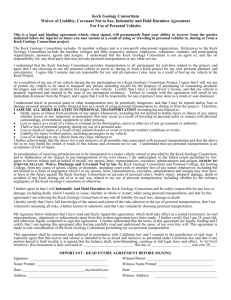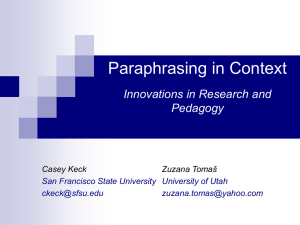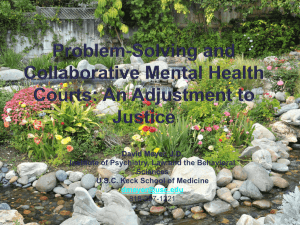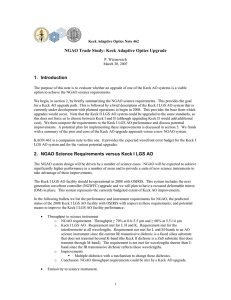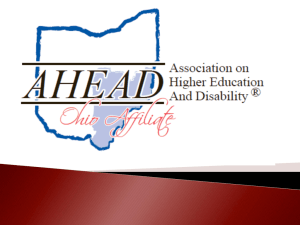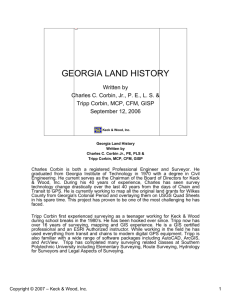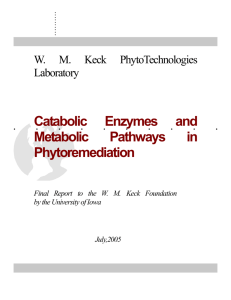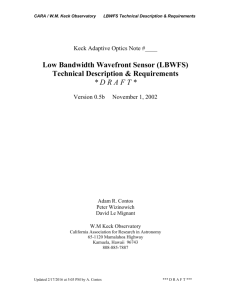on what you need to know when working with Keck
advertisement
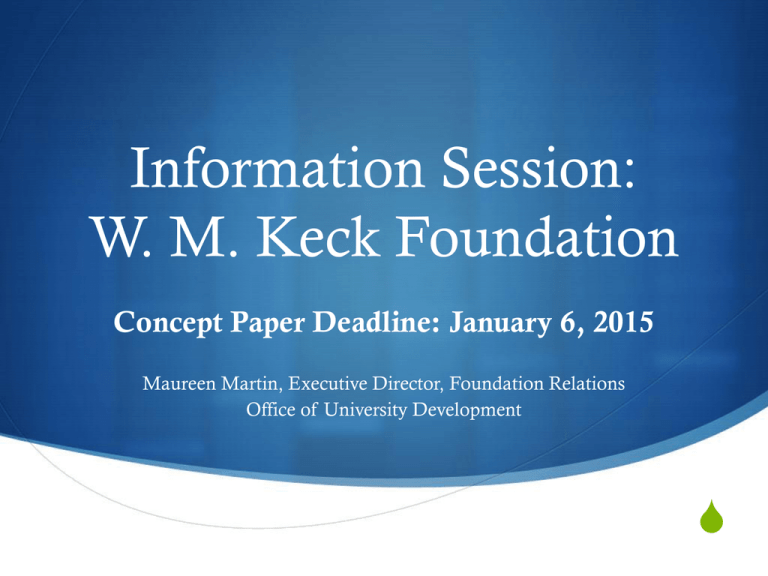
Information Session: W. M. Keck Foundation Concept Paper Deadline: January 6, 2015 Maureen Martin, Executive Director, Foundation Relations Office of University Development S Agenda S General Overview S Foundations S W. M. Keck Foundation S The Application Process S Q&A General Overview: Why Foundation Funding? S Prestige – junior and senior faculty awards – Packard, Sloan, BWF, Ellison, etc S Support “out-of-the-box” ideas S Fund higher-risk projects S Some offer a focus on a particular disease S Pilot funding, proof of concept S Round out funding for a larger project (or support salary or lab costs) Why Foundations support Science S Push the envelop of science (bridge innovative ideas into the feds - they want to be where no one else is) S Some think federal grant system of review is broken or isn’t paying enough attention to their particular area of interest. S Focus researchers attention on a particular problem or disease (this can include associations and venture philanthropy) S Think private philanthropy can have quicker ‘on the ground’ answers and impact to the world’s problems (Gates) S Support Junior Faculty in launching their careers What does the (Development) Foundation Relations office do? S Provide ideas of Foundations that would be interested in your work S Advise on approach to a Foundation S Feedback on proposal drafts S Recruit mentors for particular applications S Celebrate your success S Track opportunities as they arise - advertise and target W. M. Keck Foundation Motivation S The W.M. Keck Foundation was founded by William Myron Keck (1880-1964), an entrepreneur and innovator in the oil business, as well as a wild cat oil man who founded Superior Oil Company. Mr. Keck pioneered many of the oil extraction methods still used today including directional drilling, seismic exploration and off-shore drilling. S The foundation was created in 1954 to further Mr. Keck’s passion for imaginative and innovative science. Mr. Keck broke barriers in science and oil exploration, and the breakthroughs that he made had an impact on many other industries as well. The W.M. Keck Foundation continues his legacy by funding projects that can unlock the boundaries of current science or find new ways of doing research that advance science in new domains. Award Overview S Two very connected Research programs within the Foundation S Science and Engineering - Supports pioneering science and engineering research and the development of promising new technologies. S Medical Science – Seeks to advance the frontiers of the life sciences by supporting basic research that is high-risk Both seek projects that are distinctive and novel in their approach to problems, or question the prevailing paradigm, or push the edge/break open new territory/have the potential to transform their field. Research Project Award Overview S Award Amount: $500,000 to $5,000,000 (for 2-3 years) direct costs Likely - $1.5m to $2m, with some affection for $3m S Number of awards in 2013: 22 S No predetermination of how many awards in each of their two programs. 50/50 in 2013. S Abstracts are available online. S Funding has some restrictions S No indirect costs (can be considered UM contribution) S No tuition (also considered UM contribution) S No more than 10% of PI’s salary allowed S No more than 10% of the cost of renovation Application Process Overview S Internal Concept Papers for funding eleven months later – June and January S S S S Phase I Foundation Deadlines – November 1 and May 1 S S S S S Selection of up to 4 concepts in each program to present to foundation for feedback and advice – before August 15 and February 15 UMOR reviews with foundation staff in July and January Advice used to select up to one idea to move forward to each program 3 Pages, optimally delivered to the foundation one to two weeks early Deep, concise and compelling language. Examples available. Phase II – invitation only – quick turnaround for February 15 and August 15 Site Visit – Approximately 1-2 months after Phase II deadline Final Decision - Board selects finalists at June and December meeting (start date July 1 or January 1) S S January/Winter concept cycle is funded at following December board meeting July/ Summer concept cycle is funded at following June board meeting Characteristics of Success S S S S S S S S Explain clearly the overarching goal of the project, articulating both the approach (what) and methodology (how) that will be used. How might this be transformational? What’s the big deal? Focus on emerging areas of research Envision the future state their work would enable Have the potential to develop breakthrough technologies, instrumentation or methodologies Are innovative, distinctive and interdisciplinary Demonstrate a high level of risk due to unconventional approaches, or by challenging the prevailing paradigm Have the potential for transformative impact, such as founding a new field of research, impacting multiple fields simultaneously, enabling observations not previously possible or the altering the perception of a previously intractable problem Bring together a complementary team of researchers from unique disciplines, each one delivering innovative work Applying: Getting Started S Step 1: Treat the internal call like a full competition S Step 2: Research past winners S Get a sense of the high-risk ideas being funded S Review their documentation and the intensity of the language they use S Note their science advisors and the caliber of their work S Abstract provided in grants lists is part of the proposal – your first paragraph should be this accessible and clear. Applying: Writing the Proposal S Step 3: Tell the Story Well S Grantsmanship makes a difference S Write good science that is accessible to a smart 'lay' audience of scientists (we can help) S Communicate clearly and build excitement for your work: be explicit about why and how your work is innovative and risky you are poised to have a huge impact on your field S Be clear on what you will do and how you will achieve success S Explain why Keck funding is necessary to carry out your work (why isn't this fundable by federal sources). S Envision how your work will change the game in the fields being engaged Keck instructions on concept papers S Two-page concepts in 12 point font with 1 inch margins should include: S S S S S S S PI name and the Keck category for funding an introduction for internal reviewers of what the work is and why it’s amazing. an overview of the proposed project emphasizing any unique aspects and pilot studies (for Research Program concepts, indicate area of emphasis for project - medical research or science and engineering research); a description of the methodologies and key personnel; why each one a brief justification of the need for Keck support; and an estimated budget broken down, if possible, by major areas, e.g., personnel, equipment, consumable supplies, etc. (budgets can be rough approximations at this stage). If there’s room, the authors are free to add other details (e.g., background to put the research into perspective, description of the institution’s prominence in the field, etc.). Avoid illustrations in these single-pagers – the researchers will need all the room for text. If a reference is necessary, abbreviate it as (Science, 323, 45, ‘11). DO NOT USE (Jones et al., 2011). Sample Outline - Concept Paper S Include PI name, Project Title and Team at the top of the page. S Impact Statement: one to two sentences in bold that describe your idea and its potential impact. S Describe the following three things: 1) the problem your idea is trying to solve, 2) how current barriers will be overcome, and 3) a clear vision of what will be gained. Include a statement on why your idea is an unconventional or creative approach to the stated problem. S Describe the scientific basis for your proposed idea and why you expect it to succeed S Describe your experimental plan: Highlight the ‘What’ and “How” S Why Keck: Be explicit about why the proposed project is outside the range of federal sponsors? (have you proposed your idea to them? Talked to program officers, etc). Common Strengths S Idea clearly pushing boundary of science forward. Clearly a big deal. S Well written – clear and explicit statements that lead the reviewer to understand why the idea is ‘cool’, ‘big’, ‘game-changer’, tranformative – your overview paragraph is the ‘hook’ S Strong Team – pushing boundaries in each engaged discipline S Developing a completely new instrument/ new methodology S Controversial approach, not current ‘fad’ S Counter to current focus of the field Common Strengths: Feedback from the Foundation Common Comments from the W. M. Keck Foundation: S There is sufficient information in the ‘what’ the team will do and the ‘how’ – not too much space spent on the ‘why’ S Clear, explicit statements on what the big impact will be of the work, if successful S The best concepts clearly distinguish proposed work from the field (they often say ‘we see a lot of proposals in this space’) S Case can be strengthened if faculty have applied and been declined by federal agency (can be just a phone call with the program officer) Common Weaknesses S Lacks problem statement S Missing key partners (e.g. technology proposal lacks expert in biological field where they plan to use their technology) S We can’t see why THIS work will be transformative. Didn’t the big thing happen at the last stage? S Doable – not risky. Too iterative S Proposal too far along, already have had funding in this space S Doesn’t differentiate the proposed work from work currently funded by the engaged PIs (e.g. innovator award, career award, etc.) Common Weaknesses S Work is too applied (e.g. focused on drug discovery, device to be used in the clinic, etc). Too far downstream in a particular disease. S Lacks collaborators S Writing is not accessible to diverse set of reviewers (Advice: Write to an non-expert audience of smart scientists and engineers) S Doesn’t challenge ideas, is a conventional approach S Too focused on a particular disease (Advice: focus more on methods being developed that could transform the basic science) Questions? S Contact Information Maureen S Martin, Executive Director, Foundation Relations Email: martinms@umich.edu Phone: 734-647-6074 S Submit your concept to: UMORlimitedsubmissions@umich.edu
